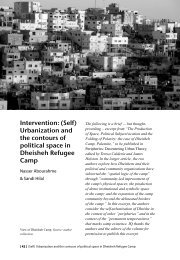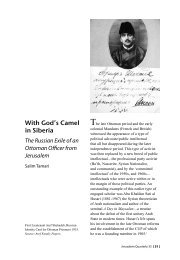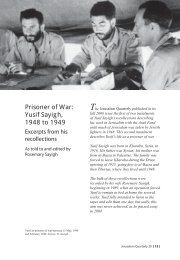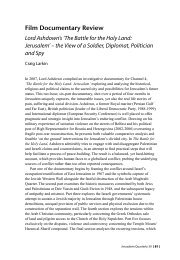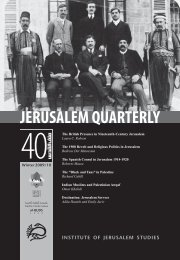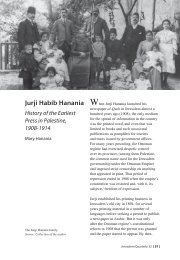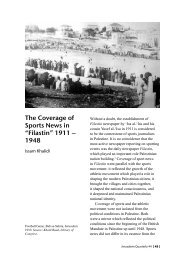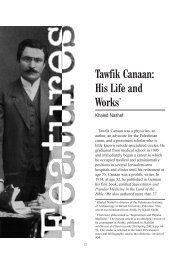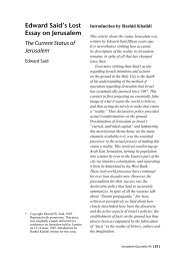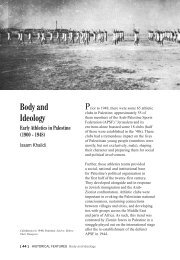PLUNDERING PALESTINE - Jerusalem Quarterly
PLUNDERING PALESTINE - Jerusalem Quarterly
PLUNDERING PALESTINE - Jerusalem Quarterly
Create successful ePaper yourself
Turn your PDF publications into a flip-book with our unique Google optimized e-Paper software.
Khalat al-Qadat<br />
The most interesting and elaborate archaeological remains in the area that will be<br />
cut from Aboud after the construction of the Wall are concentrated in and around<br />
Khalat al-Qadat. The most interesting element identified in our survey was a pyramidlike<br />
structure with exteriorly dressed stones measuring nearly 8x8 meters with<br />
thick walls standing at a height of 2.5 meters. The walls of this structure are very<br />
thick (approximately two meters), making the interior area a relatively modest 4x4<br />
meters divided into two rooms. The first room upon entering the structure measures<br />
approximately 2.5m x 4m and the anterior room measures 1.5m x 4m. A wall with a<br />
door in the middle separates these two rooms.<br />
The initial interpretation of this structure is that it is most likely an early Roman<br />
temple. The architecture of the structure is consistent with other Roman temples<br />
found in Palestine, particularly the Augustus Temple at Sebastia, although the latter<br />
features dressed stone. This difference is probably due to the fact that Sebastia was a<br />
royal city, while Aboud was a rural site. The small interior space is further indicative<br />
of Roman or even Canaanite temples and excludes the possibility that the structure<br />
served as a church or basilica, as the local people of the village refer to it. The interior<br />
space would not support a congregation, as is typical in Christian worship, but would<br />
be suited for worship conducted by high priests and/or the king, with the public<br />
gathering for worship in the courtyard immediately outside the temple. The courtyard<br />
area in front of this structure is quite large and littered with the remains of the original<br />
structure, including the stone door frame and fragments of columns. An initial surface<br />
survey in the vicinity of this structure revealed a few Roman shards; this should not be<br />
considered diagnostic, however, as the land has been cultivated for many years.<br />
Wine/Olive Presses<br />
Approximately 200m west of the pyramid-like structure, the PACE survey team<br />
identified several wine/olive presses carved into the bedrock. The most well-preserved<br />
of these was a press measuring five meters in diameter, which was likely used for<br />
both wine making and olive oil production. At the northern end of the press are three<br />
collection points for the pressed liquids. The liquid would run from the press through<br />
channels carved into the rock and collect in one of three pits cut into the rock. The first<br />
pit is circular, measuring 30cm in diameter; the second and third pits are rectangular<br />
in shape, measuring 1m x 60cm each. All three pits measure approximately 30cm in<br />
depth. The smallest pit was likely used as a primary collection point, with the second<br />
and third pits being used to separate impurities from the wine or olive oil. Such a<br />
system of purification would be particularly necessary in olive oil production, where<br />
the oil would have to be separated from water.<br />
The survey, conducted by a PACE team with the assistance of Ahmed Qasim, a 78-<br />
year-old resident of Aboud and his grandson, located an artificial water pool with<br />
[ 48 ] FEATURES VieLooting and ‘Salvaging’



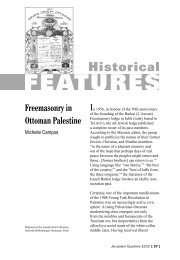
![In Search of Jerusalem Airport [pdf] - Jerusalem Quarterly](https://img.yumpu.com/49007736/1/180x260/in-search-of-jerusalem-airport-pdf-jerusalem-quarterly.jpg?quality=85)
